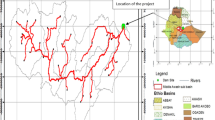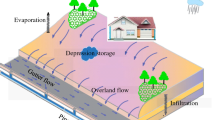Abstract
The 1D sewer - 2D surface coupled hydrodynamic model has increasingly become an essential tool for simulating and predicting the flood process and is widely used in the study of urban rainfall-runoff simulation. The current method of using the smaller time step of the sub model in the coupled model as the synchronization time greatly limits the computational efficiency, especially in the case of the large data amount or models executed in different platforms and in various types of codes. To evaluate the impact of time synchronization on the rainfall-runoff process in a coupled hydrodynamic model, a new model that couples the 2D GPU accelerated shallow water model and the 1D SWMM is applied to two urban catchments to simulate the rainfall-runoff-drainage processes, the fixed time step (5 s, 10 s, 30 s, 60 s, 120 s, 180 s and 300 s) is adopted to ensure the calculation efficiency and precision of the model. The results show that the time computational efficiency can be improved by 7.27%–27.37% in different scenarios compared with the method applying 2D model time step as the synchronization time; the surface runoff process is hardly affected as the synchronization time changes; and the relative error of the drainage process is less than 2.5% when the synchronization time is less than 60 s. Therefore, the fixed synchronization time method is recommended in the 1D-2D coupled model to improve the computational efficiency for flood and inundation simulation. Based on the advantage that the fixed synchronization time is easy to realize in the programming of the model and the high efficiency of the fixed synchronization time method concluded above, this work is expected to provide a reference for model coupling applications.








Similar content being viewed by others
Availability of Data and Materials
The data and code that support the study are available from the corresponding author upon reasonable request.
References
Chen A, Djordjević S, Leandro J, Savic D (2007) The urban inundation model with bidirectional flow interaction between 2D overland surface and 1D sewer networks. https://doi.org/10.1002/widm.1095
Chen W, Huang G, Zhang H, Wang W (2018) Urban inundation response to rainstorm patterns with a coupled hydrodynamic model: a case study in Haidian Island, China. J Hydrol 564:1022–1035. https://doi.org/10.1016/j.jhydrol.2018.07.069
DHI (1995) Mouse: User’s manual and tutorial Horsholm. Denmark, Horsholm
Echeverribar I, Morales-Hernández M, Brufau P, García-Navarro P (2020) Analysis of the performance of a hybrid CPU/GPU 1D2D coupled model for real flood cases. J Hydroinform 22. https://doi.org/10.2166/hydro.2020.032
Fan Y, Ao T, Yu H, Huang G, Li X (2017) A coupled 1D-2D hydrodynamic model for urban flood inundation. Adv Meteorol 2017:2819308. https://doi.org/10.1155/2017/2819308
Hou J, Liang Q, Zhang H, Hinkelmann R (2015) An efficient unstructured MUSCL scheme for solving the 2D shallow water equations. Environ Model Softw 66:131–152. https://doi.org/10.1016/j.envsoft.2014.12.007
Hou J, Wang N, Guo K, Li D, Jing H, Wang T, Hinkelmann R (2020) Effects of the temporal resolution of storm data on numerical simulations of urban flood inundation. J Hydrol 589:125100. https://doi.org/10.1016/j.jhydrol.2020.125100
Hsu MH, Chen SH, Chang TJ (2000) Inundation simulation for urban drainage basin with storm sewer system. J Hydrol 234:21–37. https://doi.org/10.1016/S0022-1694(00)00237-7
Huang M, Yang S, Qi W, Hou J, Zang Y (2019) Numerical simulation of urban waterlogging reduction effect in Guyuan sponge city. Water Resour Protect 35:13–18+39. https://doi.org/10.3880/j.issn.1004-6933.2019.05.003
Innovyze (2014) InfoWorks ICM Help v5.0.
Leandro J, Chen AS, Djordjević S, Savić DA (2009) Comparison of 1D/1D and 1D/2D coupled (sewer/surface) hydraulic models for urban flood simulation. J Hydraul Eng 135:495–504. https://doi.org/10.1061/(ASCE)HY.1943-7900.0000037
Li B, Hou J, Li D, Yang D, Han H, Bi X, Wang X, Hinkelmann R, Xia J (2021) Application of LiDAR UAV for high-resolution flood modelling. Water Resour Manage 35:1433–1447. https://doi.org/10.1007/s11269-021-02783-w
Li D, Hou J, Xia J, Tong Y, Yang D, Zhang D, Gao X (2020) An efficient method for approximately simulating drainage capability for urban flood. Front Earth Sci 8. https://doi.org/10.3389/feart.2020.00159
Pal SC, Chowdhuri I, Das B, Chakrabortty R, Roy P, Saha A, Shit M (2022) Threats of climate change and land use patterns enhance the susceptibility of future floods in India. J Environ Manage 305. https://doi.org/10.1016/j.jenvman.2021.114317
Pan ZP, Tong Y, Hou JM, Zheng J, Kang YD, Wang Y, Cao CC (2021) Hole irrigation process simulation using a soil water dynamical model with parameter inversion method. Agric Water Manage 245. https://doi.org/10.1016/j.agwat.2020.106542
Panagopoulos A (2021a) Beneficiation of saline effluents from seawater desalination plants: Fostering the zero liquid discharge (ZLD) approach - a techno-economic evaluation. J Environ Chem Engi 9. https://doi.org/10.1016/j.jece.2021.105338
Panagopoulos A (2021b) Energetic, economic and environmental assessment of zero liquid discharge (ZLD) brackish water and seawater desalination systems. Energy Convers Manage 235. https://doi.org/10.1016/j.enconman.2021.113957
Qi W, Ma C, Xu H, Chen Z, Zhao K, Han H (2021) Low impact development measures spatial arrangement for urban flood mitigation: an exploratory optimal framework based on source tracking. Water Resour Manag35:3755–3770. https://doi.org/10.1007/s11269-021-02915-2
Rossman LA (2009) Storm water management model user’s manual. US EPA
Seyedashraf O, Bottacin-Busolin A, Harou JJ (2021) Many-objective optimization of sustainable drainage systems in urban areas with different surface slopes. Water Resour Manage 35:2449–2464. https://doi.org/10.1007/s11269-021-02840-4
Tansar H, Duan H-F, Mark O (2022) Catchment-scale and local-scale based evaluation of LID effectiveness on urban drainage system performance. Water Resour Manage 36:507–526. https://doi.org/10.1007/s11269-021-03036-6
Yang L, Li J, Kang A, Li S, Feng P (2020) The effect of nonstationarity in rainfall on urban flooding based on coupling SWMM and MIKE21. Water Resour Manage 34:1535–1551. https://doi.org/10.1007/s11269-020-02522-7
Yin D, Evans B, Wang Q, Chen Z, Jia H, Chen AS, Fu G, Ahmad S, Leng L (2020) Integrated 1D and 2D model for better assessing runoff quantity control of low impact development facilities on community scale. Sci Total Environ 720:137630. https://doi.org/10.1016/j.scitotenv.2020.137630
Zhu S, Li D, Huang G, Chhipi-Shrestha G, Nahiduzzaman KM, Hewage K, Sadiq R (2021) Enhancing urban flood resilience: a holistic framework incorporating historic worst flood to Yangtze River Delta, China. Int J Disaster Risk Reduct 61:102355. https://doi.org/10.1016/j.ijdrr.2021.102355
Funding
This work is partly supported by the National Natural Science Foundation of China (52079106, 52009104) and the IWHR Research & Development Support Program (WH0145B022021).
Author information
Authors and Affiliations
Contributions
Conceptualization and Methodology: J. Hou, D. Li; Writing-original draft preparation: D. Li; Material preparation, collection and analysis: D. Li, Y. Zhang, M. Guo, D; Supervision: Zhang, X; Funding acquisition: J. Hou.
Corresponding author
Ethics declarations
Ethics Approval
Informed consent.
Consent to Participate
Not applicable.
Consent to Publish
The authors are indeed informed and agree to publish.
Competing Interests
None.
Additional information
Publisher's Note
Springer Nature remains neutral with regard to jurisdictional claims in published maps and institutional affiliations.
Rights and permissions
About this article
Cite this article
Li, D., Hou, J., Zhang, Y. et al. Influence of Time Step Synchronization on Urban Rainfall-Runoff Simulation in a Hybrid CPU/GPU 1D-2D Coupled Model. Water Resour Manage 36, 3417–3433 (2022). https://doi.org/10.1007/s11269-022-03158-5
Received:
Accepted:
Published:
Issue Date:
DOI: https://doi.org/10.1007/s11269-022-03158-5




